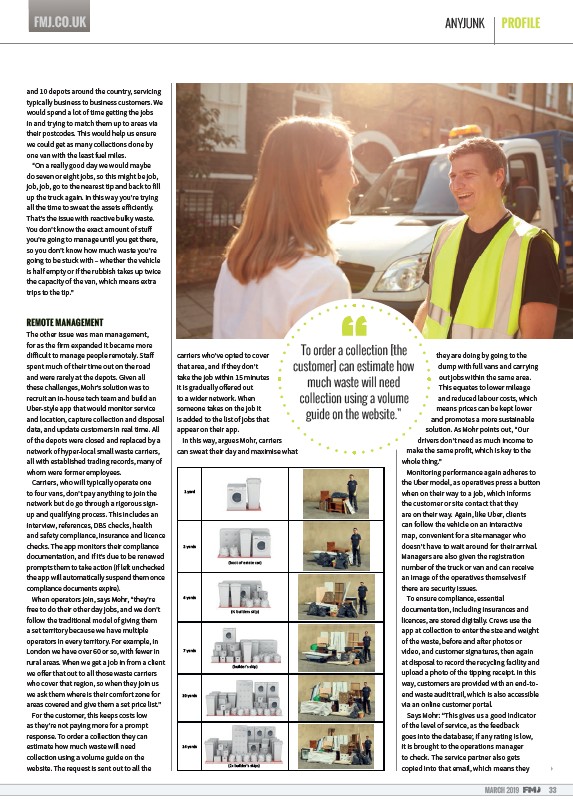
FMJ.CO.UK ANYJUNK PROFILE
MARCH 2019 33
and 10 depots around the country, servicing
typically business to business customers. We
would spend a lot of time getting the jobs
in and trying to match them up to areas via
their postcodes. This would help us ensure
we could get as many collections done by
one van with the least fuel miles.
“On a really good day we would maybe
do seven or eight jobs, so this might be job,
job, job, go to the nearest tip and back to fill
up the truck again. In this way you’re trying
all the time to sweat the assets e‚ iciently.
That’s the issue with reactive bulky waste.
You don’t know the exact amount of stu‚
you’re going to manage until you get there,
so you don’t know how much waste you’re
going to be stuck with – whether the vehicle
is half empty or if the rubbish takes up twice
the capacity of the van, which means extra
trips to the tip.”
REMOTE MANAGEMENT
The other issue was man management,
for as the firm expanded it became more
di‚ icult to manage people remotely. Sta‚
spent much of their time out on the road
and were rarely at the depots. Given all
these challenges, Mohr’s solution was to
recruit an in-house tech team and build an
Uber-style app that would monitor service
and location, capture collection and disposal
data, and update customers in real time. All
of the depots were closed and replaced by a
network of hyper-local small waste carriers,
all with established trading records, many of
whom were former employees.
Carriers, who will typically operate one
to four vans, don’t pay anything to join the
network but do go through a rigorous signup
and qualifying process. This includes an
interview, references, DBS checks, health
and safety compliance, insurance and licence
checks. The app monitors their compliance
documentation, and if it’s due to be renewed
prompts them to take action (if lež unchecked
the app will automatically suspend them once
compliance documents expire).
When operators join, says Mohr, “they’re
free to do their other day jobs, and we don’t
follow the traditional model of giving them
a set territory because we have multiple
operators in every territory. For example, in
London we have over 60 or so, with fewer in
rural areas. When we get a job in from a client
we o‚ er that out to all those waste carriers
who cover that region, so when they join us
we ask them where is their comfort zone for
areas covered and give them a set price list.”
For the customer, this keeps costs low
as they’re not paying more for a prompt
response. To order a collection they can
estimate how much waste will need
collection using a volume guide on the
website. The request is sent out to all the
they are doing by going to the
dump with full vans and carrying
out jobs within the same area.
This equates to lower mileage
and reduced labour costs, which
means prices can be kept lower
and promotes a more sustainable
solution. As Mohr points out, “Our
drivers don’t need as much income to
To order a collection the
customer can estimate how
much waste will need
collection using a volume
guide on the website.”
make the same profit, which is key to the
whole thing.”
Monitoring performance again adheres to
the Uber model, as operatives press a button
when on their way to a job, which informs
the customer or site contact that they
are on their way. Again, like Uber, clients
can follow the vehicle on an interactive
map, convenient for a site manager who
doesn’t have to wait around for their arrival.
Managers are also given the registration
number of the truck or van and can receive
an image of the operatives themselves if
there are security issues.
To ensure compliance, essential
documentation, including insurances and
licences, are stored digitally. Crews use the
app at collection to enter the size and weight
of the waste, before and až er photos or
video, and customer signatures, then again
at disposal to record the recycling facility and
upload a photo of the tipping receipt. In this
way, customers are provided with an end-toend
waste audit trail, which is also accessible
via an online customer portal.
Says Mohr: “This gives us a good indicator
of the level of service, as the feedback
goes into the database; if any rating is low,
it is brought to the operations manager
to check. The service partner also gets
copied into that email, which means they
1 yard
2 yards
(boot of estate car)
4 yards
(½ builders skip)
7 yards
(builder’s skip)
10 yards
14 yards
(2x builder’s skips)
carriers who’ve opted to cover
that area, and if they don’t
take the job within 15 minutes
it is gradually o‚ ered out
to a wider network. When
someone takes on the job it
is added to the list of jobs that
appear on their app.
In this way, argues Mohr, carriers
can sweat their day and maximise what